Konark Sun Temple
| Sun Temple, Konark, Odisha କୋଣାର୍କ ସୂର୍ଯ୍ୟ ମନ୍ଦିର , ଓଡିଶା | |
|---|---|
| Name as inscribed on the World Heritage List | |
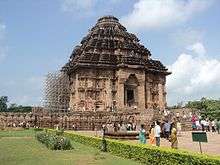 | |
| Type | Cultural |
| Criteria | i, iii, vi |
| Reference | 246 |
| UNESCO region | List of World Heritage Sites in Asia and Australasia |
| Inscription history | |
| Inscription | List of World Heritage Sites by year of inscription#1984 (8th session) (8th Session) |
 Location of Konark Sun Temple in India. | |
Konark Sun Temple is a 13th-century CE Sun Temple at Konark in Odisha, India. It is believed that the temple was built by king Narasimhadeva I of Eastern Ganga Dynasty[1] in 1255 CE.[2] The temple complex is in the shape of a gigantic chariot, having elaborately carved stone wheels, pillars and walls.[3] A major part of the structure is now in ruins. The temple is a UNESCO World Heritage Site[4] and has also featured on various list of Seven Wonders of India. The temple is 35 km from Puri and 65 km from Bhubaneswar.
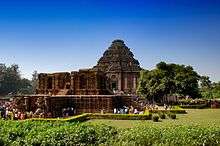

Etymology
The name Konark derives from the combination of the Sanskrit words, Kona (corner or angle) and Ark (the sun), in reference to the temple which was dedicated to the Sun God Surya.[4]
The monument was also called the Black Pagoda'(Kaala Pagoda) by the European sailors. In contrast, the Jagannath Temple in Puri was called the White Pagoda. Both temples served as important landmarks for the sailors.[5] Konark Sun Temple used Iron beams for its structure.
Architecture


The temple was originally built at the mouth of the river Chandrabhaga, but the waterline has receded since then. The temple has been built in the form of a giant ornamented chariot of the Sun god, Surya. It has twelve pairs of elaborately carved stone wheels which are 3 meters[4] wide and is pulled by a set of seven horses (4 on the right and 3 on the left).[6] The temple follows the traditional style of Kalinga architecture. It is carefully oriented towards the east so that the first rays of sunrise strikes the principal entrance.[4] The temple is built from Khondalite rocks.[7][8]
The original temple had a main sanctum sanctorum (vimana), which was supposedly 229 feet[6] (70 m) tall. Due to the weight of the superstructure (70 m tall) and weak soil of the area, the main vimana fell in 1837.[9] The audience hall (Jagamohana), which is about 128 feet (39 m) tall, still stands and is the principal structure in the surviving ruins. Among the structures, which have survived to the current day, are the dance hall (Nata mandira) and dining hall (Bhoga mandapa).[4][6]
The Konark temple is also known for its erotic sculptures of maithunas.[10]
Two smaller ruined temples have been discovered nearby. One of them is called the Mayadevi Temple and is located southwest from the entrance of the main temple. It is presumed to have been dedicated to Mayadevi, one of the Sun god's wives. It has been dated to the late 11th century, earlier than the main temple.[11] The other one belongs to some unknown Vaishnava deity. Sculptures of Balarama, Varaha and Trivikrama have been found at the site, indicating it to be a Vaishnavite temple. Both temples have their primary idols missing.
A collection of fallen sculptures can be viewed at the Konark Archaeological Museum which is maintained by the Archaeological Survey of India.[12]
Famous Quotes
Here the language of stone surpasses the language of human.
History
Ancient Texts
According to Bhavishya Purana and Samba Purana, there may have been a sun temple in the region earlier than current one, dating to the 9th century or earlier.[15] The books mention three sun temples at Mundira (possibly Konark), Kalapriya (Mathura), and Multan.[16][17]
According to the scriptures, Samba, the son of Krishna, was cursed with leprosy. He was advised by the sage, Kataka, to worship the sun god to cure his aliment. Samba underwent penance for 12 years in Mitravana near the shores of Chandrabhaga.[18] Both the original Konark temple and the Multan temple[19] have been attributed to Samba.
The Periplus of the Erythraean Sea (1st Century CE) mentions a port called Kainapara, which has been identified as current day Konark.[20]
Sun Dial and Time
The wheels of the temple are sundials which can be used to calculate time accurately to a minute including day and night.[21]
Second Temple
According to the Madala Panji, there was another temple in the region. It was built by one Pundara Kesari. He may have been Puranjaya, the 7th century ruler, of the Somavasmi Dynasty.[22]
Narasimhadeva I
The current temple is attributed to Narasimhadeva I of the Eastern Ganga Dynasty. His reign spanned from 1238 to 1264 CE. The temple may have been a monument to his victory against Tughral Tughan Khan.[18][23]
Dharmapada's Tale
According to local folklore, Narasimhadeva I had hired a chief architect called Bisu Maharana to build the temple. After a period of twelve years, a workforce of twelve hundred almost finished the construction. But, they failed to mount the crown stone. The impatient king ordered the temple to be finished in three days or the artisans be put to death. At the time, Bisu Maharana's twelve-year-old son, Dharmapada arrived at the site. Bisu Maharana had never seen his son, as he had left his village when his wife was still pregnant. Dharmapada successfully proposed a solution to mount the crown stone. But, the artisans were still apprehensive that the king will be displeased to learn that a boy succeeded where his best artisans failed. Dharmapada climbed onto the temple and leapt into the water to save his father and his co-workers. According to local legend, - stated by a guide, the solution offered by Dharmapada was to place a strong magnetic rod in the dome at the top, which attracted the iron ore laden rocks and kept them stable. The collapse (see next)is supposedly related to this
Collapse

There have been several proposed theories for the collapse of the main sanctum. The date of the collapse is so not certain.
The Kenduli copper plates of Narasimha IV (Saka 1305 or 1384 CE) states the temple to be in a perfect state.[24]
In the 16th century Ain-i-Akbari, Abul Fazl also mentions Konark being in a proper state.[24] The account also mentions the cost of construction being 12 years of revenue.[25]
The cause of collapse is also placed on Kalapahad who invaded Odisha in 1568.[24]
Local legend - stated by the guides is that, the collapse was caused by removal of the strong magnetized rod at the centre which was keeping the temple structure erect by Portuguese shipmen. The strong magnetic waves emanating from it were interfering with the ships' compass and resulted in a few ship wrecks! (see above)
In 1627, the then Raja of Khurda had removed the sun idol from Konark and moved it to the Jagannath temple in Puri.[26]
James Fergusson (1808–1886) had the opinion that marshy foundation had caused the collapse.[24] But, the structure has shown no sign of sinking into its foundation.[25] Fergusson, who visited the temple in 1837, recorded a corner of the main sanctum still standing.[24] It also fell down in 1848 due to a strong gale.[22]
According to Percy Brown (1872–1955), the temple was not properly completed and so it collapsed.[24] This contradicts earlier recorded accounts of the temple being in a proper state.
In 1929, an analysis of a moss covered rock estimated the date of abandonment at around 1573.[24]
Other proposed causes include lightning and earthquake.[24]
Aruna Stambha
In the last quarter of the 18th century, when worship had ceased in the temple, the Aruna stambha (Aruna pillar) was removed from the entrance of Konark temple and placed at the Singha-dwara (Lion's Gate) of the Jagannath temple in Puri by a Maratha Brahmachari called Goswain (or Goswami).[27][28] The pillar is made of monolithic chlorite and is 33 feet 8 inches (10.26 m) tall. It is dedicated to Aruna, the charioteer of the Sun god.[28]
Preservation Efforts

In 1803, requests were made for conservations by the East India Marine Board, but only removal of stones from the site was prohibited by the Governor General. As a result, a part of the main tower, which was still standing, collapsed in 1848.[29]
The then Raja of Khurda removed some stones and sculptures to use in a temple he was building in Puri. A few gateways and some sculptures were destroyed in the process.[30] In 1838, after the depredation of the Raja of Khurda, Asiatic Society of Bengal requested conservation, but the requests were denied and only preventative of human-caused damages were guaranteed.[29] The Raja was forbidden to remove any more stones.
In 1859, Asiatic Society of Bengal proposed moving an architrave depicting the navagraha to the Indian Museum in Calcutta. The first attempt in 1867 was abandoned as the funds ran out.[29]
In 1894, thirteen sculptures were moved to the Indian Museum.[29]
In 1903 when a major excavation was attempted nearby, the then Lieutenant governor of Bengal, J. A. Baurdilon, ordered the temple to be sealed and filled with sand to prevent the collapse of the Jagamohana.[24][31]
In 1906, casuarina and punnang trees were planted facing the sea to buffer the site against sand-laden winds.[29]
In 1909, the Mayadevi temple was discovered while removing sand and debris.[29]
The temple was granted World Heritage Site status by the UNESCO in 1984.[4]


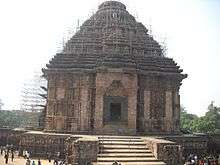
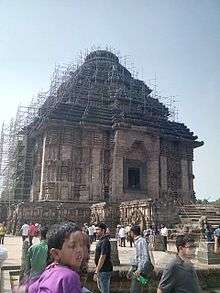


Gallery
Antique paintings and photographs
-

Watercolour painting of two European officers with a dog exploring the interior (1812)
-

Watercolour "somnath"drawing of the north view of Konark (1820). It depicts part of the main tower still standing.
-
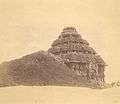
Photograph of a general view from the south-west (c.1890).
-

Arunastambha at the Singhadwara at Jagannath Temple in Puri (1870)
Current day photographs
-

Nata mandir
-

Front view of Nata mandir
-

A simha-gaja at the entrance
-
One of the carved wheels
-

A close-up of a wheel
-

A weathered horse sculpture
-

A secondary statue of the Sun god
-

A sculpture on the temple wall
-
Mayadevi Temple at Konark
-

Sculpture of a crocodile head on Mayadevi Temple
-

Vaishnava Temple
-

Sanctum of the Vaishnava Temple
-

A plaque declaring Konark to be a World Heritage Site
-

A plaque declaring Konark to be the Kainapara of the Periplus. It puts the date of construction at c. 1250.
-

A close-up of a wheel
-
Carvings on the Sun temple
-

A sculpture on the temple wall
-
A sculpture of a crocodile head
-

A sculpture taken from the site at the British Museum
-

A simha-gaja at the entrance
-
Konark Sun Temple
-
Replica of Sun Temple at Gwalior
-

Elephants of Konark Temple
-

Close up of Wheel Axle
-

Ornated Wheel of the temple chariot
-

GajaNarasimha - Lion on Elephant at the Gateway
See also
- History of Odisha
- Solar deity
- Konark Dance Festival, an annual event held at this site
References
- ↑ Sen, Sailendra (2013). A Textbook of Medieval Indian History. Primus Books. pp. 121–122. ISBN 978-9-38060-734-4.
- ↑ Indian History. Tata McGraw-Hill Education. p. 2. ISBN 978-0-07-132923-1. Retrieved 3 May 2013.
- ↑ "Konark Sun Temple".
- 1 2 3 4 5 6 "Sun Temple, Konârak". UNESCO. Retrieved 3 May 2013.
- ↑ Lewis Sydney Steward O'Malley (1 January 2007). Bengal District Gazetteer : Puri. Concept Publishing Company. p. 283. ISBN 978-81-7268-138-8. Retrieved 3 May 2013.
- 1 2 3 "Official website: The Sun Temple". Tourism Department, Government of Orissa. Retrieved 3 May 2013.
- ↑ N. Chenna Kesavulu (1 February 2009). Textbook of Engineering Geology. Macmillan Publishers India Limited. p. 188. ISBN 978-0-230-63870-9. Retrieved 27 July 2013.
- ↑ P. C. Varghese (November 2012). Engineering Geology for Civil Engineers. PHI Learning Pvt. Ltd. p. 126. ISBN 978-81-203-4495-2. Retrieved 2 August 2013.
- ↑ Description from British Library archives, accessed 30April2014
- ↑ "Konarak Sun Temple: Mithuna Sculptures". Archaeological Survey of India. Retrieved 17 May 2011.
- ↑ "World Heritage Sites: Konarak Sun Temple". Archaeological Survey of India. Retrieved 17 May 2013.
- ↑ "Archaeological Museum, Konarak". Archaeological Survey of India. Retrieved 17 May 2013.
- ↑ Manish Telikic Chary (2 February 2009). India: Nation on the Move: An Overview of India's People, Culture, History, Economy, IT Industry, & More. iUniverse. p. 389. ISBN 978-1-4401-1635-3. Retrieved 17 May 2013.
- ↑ Somen Sengupta (22 September 2012). "Poetry in stone". Daily Pioneer. Retrieved 27 July 2013.
- ↑ Linda Kay Davidson; David Martin Gitlitz (1 January 2002). Pilgrimage: From the Ganges to Graceland : an Encyclopedia. ABC-CLIO. p. 318. ISBN 978-1-57607-004-8. Retrieved 27 July 2013.
- ↑ John M. Rosenfield (1 January 1967). The Dynastic Arts of the Kushans. [Mit Faks.]. University of California Press. p. 195. GGKEY:0379L32LPNJ. Retrieved 27 July 2013.
- ↑ N. K. Singh (2009). Coronation Of Shiva: Rediscovering Masrur Temple. Har-Anand Publications Pvt. Limited. p. 18p. ISBN 978-81-241-1478-0. Retrieved 27 July 2013.
- 1 2 "Official website: The Sun Temple Legend". Tourism Department, Government of Orissa. Retrieved 27 July 2013.
- ↑ Sir Alexander Cunningham (1871). The Ancient Geography of India: I. The Buddhist Period, Including the Campaigns of Alexander, and the Travels of Hwen-Thsang. Trübner & Company. p. 233. Retrieved 27 July 2013.
- ↑ Helaine Selin (16 April 2008). Encyclopaedia of the History of Science, Technology, and Medicine in Non-Western Cultures. Springer. pp. 1731–. ISBN 978-1-4020-4559-2. Retrieved 2 August 2013.
- ↑ https://www.youtube.com/watch?v=K9RF9lLBIMs
- 1 2 "Konark Sun Temple: Introduction". Archaeological Survey of India. Retrieved 29 July 2013.
- ↑ David H. Kelley; Eugene F. Milone (16 February 2011). Exploring Ancient Skies: A Survey of Ancient and Cultural Astronomy. Springer. p. 285. ISBN 978-1-4419-7624-6. Retrieved 27 July 2013.
- 1 2 3 4 5 6 7 8 9 "Konarak, Conservation". Archaeological Survey of India. Retrieved 27 July 2013.
- 1 2 Dr. Benudhar Patra (April 2006). "Antiquity of Arkakshetra Konark" (PDF). Orissa Review. Government of Odisha. Retrieved July 27, 2013.
- ↑ L.S.S. O'malley (1 January 2007). Bengal District Gazetteer : Puri. Concept Publishing Company. p. 47. ISBN 978-81-7268-138-8. Retrieved 2 August 2013.
- ↑ Narayan Miśra (1 January 2007). Annals and Antiquities of the Temple of Jagannātha. Sarup & Sons. p. 19. ISBN 978-81-7625-747-3. Retrieved 1 August 2013.
- 1 2 Prajna Paramita Behera (June 2004). "The Pillars of Homage toLord Jagannatha" (PDF). Orissa Review. Government of Odisha. Archived from the original (PDF) on February 22, 2014. Retrieved August 1, 2013.
- 1 2 3 4 5 6 "Konark Conservation". Government of Odisha. Retrieved 1 August 2013.
- ↑ N. S. Ramaswami (1 December 1971). Indian Monuments. Abhinav Publications. p. 166. ISBN 978-0-89684-091-1. Retrieved 2 August 2013.
- ↑ Sandeep Mishra (10 July 2010). "The Sun Temple of Orissa". The Times of India. Retrieved 27 July 2013.
Further reading
- Surya: The God and His Abode, Parijat, 2010, ISBN 81-903561-7-8
- "Konarak- The Heritage of Mankind (Set of 2)", by Karuna Sagar Behera, 1996, ISBN 978-81-7305-076-3
External links
| Wikimedia Commons has media related to Sun Temple, Konârak. |
- Konark Sun Temple (Official Website), Tourism Department, Government of Odisha
- Konark Sun Temple, World Heritage Site, UNESCO
- Konark Sun Temple, Archaeological Survey of India
- Odisha tourism portal
- Sun Temple of Konark
- Konark Sun Temple, Spherical Panorama 360°
- Reach Konark Sun Temple from Puri
Coordinates: 19°53′15″N 86°05′41″E / 19.887444°N 86.094596°E

